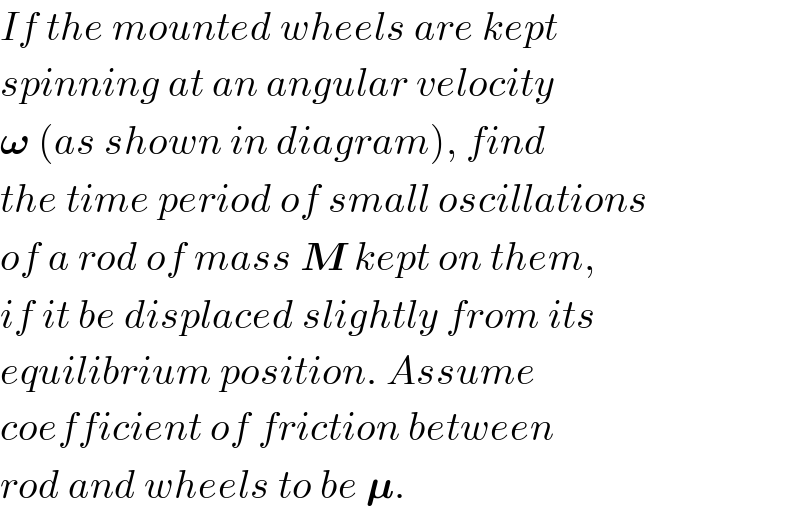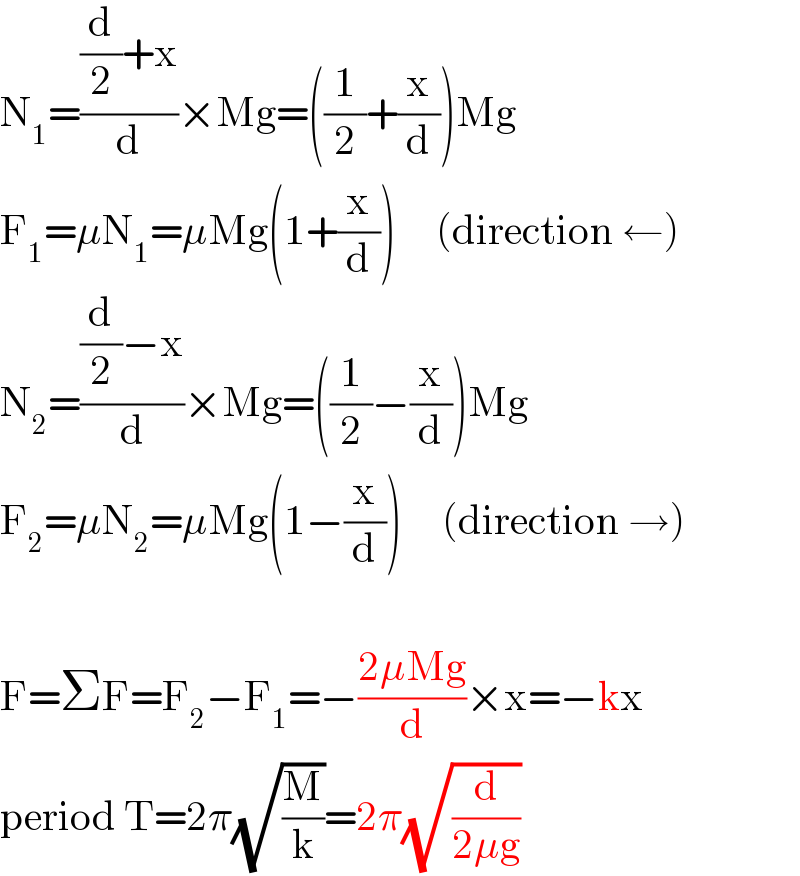
Question Number 23272 by ajfour last updated on 28/Oct/17

Commented by ajfour last updated on 28/Oct/17

$${If}\:{the}\:{mounted}\:{wheels}\:{are}\:{kept} \\ $$$${spinning}\:{at}\:{an}\:{angular}\:{velocity} \\ $$$$\boldsymbol{\omega}\:\left({as}\:{shown}\:{in}\:{diagram}\right),\:{find} \\ $$$${the}\:{time}\:{period}\:{of}\:{small}\:{oscillations} \\ $$$${of}\:{a}\:{rod}\:{of}\:{mass}\:\boldsymbol{{M}}\:{kept}\:{on}\:{them},\: \\ $$$${if}\:{it}\:{be}\:{displaced}\:{slightly}\:{from}\:{its} \\ $$$${equilibrium}\:{position}.\:{Assume} \\ $$$${coefficient}\:{of}\:{friction}\:{between} \\ $$$${rod}\:{and}\:{wheels}\:{to}\:{be}\:\boldsymbol{\mu}. \\ $$
Answered by mrW1 last updated on 29/Oct/17

Commented by mrW1 last updated on 29/Oct/17

$$\mathrm{N}_{\mathrm{1}} =\frac{\frac{\mathrm{d}}{\mathrm{2}}+\mathrm{x}}{\mathrm{d}}×\mathrm{Mg}=\left(\frac{\mathrm{1}}{\mathrm{2}}+\frac{\mathrm{x}}{\mathrm{d}}\right)\mathrm{Mg} \\ $$$$\mathrm{F}_{\mathrm{1}} =\mu\mathrm{N}_{\mathrm{1}} =\mu\mathrm{Mg}\left(\mathrm{1}+\frac{\mathrm{x}}{\mathrm{d}}\right)\:\:\:\:\:\left(\mathrm{direction}\:\leftarrow\right) \\ $$$$\mathrm{N}_{\mathrm{2}} =\frac{\frac{\mathrm{d}}{\mathrm{2}}−\mathrm{x}}{\mathrm{d}}×\mathrm{Mg}=\left(\frac{\mathrm{1}}{\mathrm{2}}−\frac{\mathrm{x}}{\mathrm{d}}\right)\mathrm{Mg} \\ $$$$\mathrm{F}_{\mathrm{2}} =\mu\mathrm{N}_{\mathrm{2}} =\mu\mathrm{Mg}\left(\mathrm{1}−\frac{\mathrm{x}}{\mathrm{d}}\right)\:\:\:\:\:\left(\mathrm{direction}\:\rightarrow\right) \\ $$$$ \\ $$$$\mathrm{F}=\Sigma\mathrm{F}=\mathrm{F}_{\mathrm{2}} −\mathrm{F}_{\mathrm{1}} =−\frac{\mathrm{2}\mu\mathrm{Mg}}{\mathrm{d}}×\mathrm{x}=−\mathrm{kx} \\ $$$$\mathrm{period}\:\mathrm{T}=\mathrm{2}\pi\sqrt{\frac{\mathrm{M}}{\mathrm{k}}}=\mathrm{2}\pi\sqrt{\frac{\mathrm{d}}{\mathrm{2}\mu\mathrm{g}}} \\ $$
Commented by ajfour last updated on 29/Oct/17

$${Thanks}\:{a}\:{lot},\:{Sir}. \\ $$
